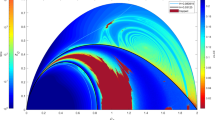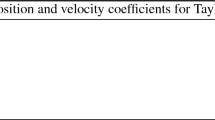Abstract
The purpose of the paper is to furnish two analytic contributions to the Störmer problem (motion of a charged particle in a magnetic dipole field). The fundamental role in these considerations is played by a quantity which depends on the constant velocity of the particle: by treating this quantity or its reciprocal as a small parameter, power series solutions can be obtained for the orbit projection upon a meridian plane valid for both low-energy and high-energy particles.
For high-energy particles, the zero-order approximation is in general an ellipse, but will reduce to a straightline for particular values of the integration constants.
For low-energy particles, the zero-order approximation is given as an infinite series in the variablew=sin2λ, λ being the latitude, and it is shown that this basic orbit is not a magnetic line of force.
Leading terms of the expansions have been given for the first-order approximations in both cases. Higher-order approximations can be obtained recurrently by solving linear, first-order differential equations having the same integrating factor, which depends on the zero-order approximation alone.
The method is suitable for extensive numerical work in conjunction with a computer program of the ‘formac’ class.
Similar content being viewed by others
References
Alfvén, H. andFälthammar, C. G.: 1963,Cosmical Electrodynamics, 2nd ed., Clarendon Press, Oxford.
Chamberlain, J. W.: 1958, ‘Theories of the Aurora’, inAdvances in Geophysics,4, Academic Press, New York, pp. 109–215.
DeVogelaere, R.: 1958, ‘On the Structure of Symmetric Periodic Solutions of Conservative Systems, With Applications’,Contributions to the Theory of Nonlinear Oscillations 4, Princeton University Press, Princeton, N.J., pp. 53–84.
Dragt, A. J.: 1965, ‘Trapped Orbits in a Magnetic Dipole’,Reviews of Geophysics 3, 255–298.
Graef, C. andKusaka, S.: 1938, ‘On Periodic Orbits in the Equatorial Plane of a Magnetic Dipole’,J. Math. Phys. 17, 43–54.
Lemaître, G. andBossy, L.: 1945, ‘Sur un cas limite du problème de Störmer’,Acad. Roy. Belg. 31, 357–364.
Malmquist, J.: 1944, ‘Sur les systèmes d'équations différentielles’,Ark. Math. Astr. och Fysik 30, 1–8.
Northrop, T. G.: 1963,The Adiabatic Motion of Charged Particles, Interscience Publishers, New York.
Rajappa, N. et al.: 1967, ‘The Geomagnetic Cavity and the Van Allen Radiation Belts’,Planetary Space Sci. 15, 495–502.
Ray, E. C.: 1963, ‘On the Motion of Charged Particles in the Geomagnetic Field’,Ann. Phys. 24, 1–18.
Stern, D.: 1967, ‘Störmer Theory and Euler Potentials’,Planetary Space Sci. 15, 1525–1530.
Störmer, C.: 1955,The Polar Aurora, Clarendon Press, Oxford.
Vallarta, M. S.: 1961, ‘Theory of the Geomagnetic Effects of Cosmic Radiation’, inHandbuch der Physik 46, Springer-Verlag, Berlin, pp. 88–129.
Author information
Authors and Affiliations
Rights and permissions
About this article
Cite this article
Lanzano, P. Analytic contributions to the Störmer problem. Astrophys Space Sci 2, 319–333 (1968). https://doi.org/10.1007/BF00650909
Received:
Issue Date:
DOI: https://doi.org/10.1007/BF00650909




